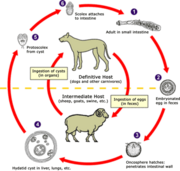Hydatidosis
Echinococcosis, also known as hydatid disease, is a potentially fatal parasitic disease that can affect many animals, including wildlife, commercial livestock and humans. more...
The Echinococcosis Cycle
The disease results from infection by tapeworm larvae of the genus Echinococcus - notably E. granulosus, E. multilocularis, and E. vogeli.
Like many parasite infections, the course of Echinococcus infection is complex. The worm has a life cycle that requires definitive hosts and intermediate hosts. Definitive hosts are normally carnivores such as dogs, while intermediate hosts are usually herbivores such as sheep and cattle. Humans also function as intermediate hosts, although they are usually a 'dead end' for the parasitic infection cycle.
The disease cycle begins with an adult tapeworm infecting the intestinal tract of the definitive host. The adult tapeworm then produces eggs which are expelled in the host's feces.
Intermediate hosts become infected by ingesting the eggs of the parasite. Inside the intermediate host, the eggs hatch and release tiny hooked embryos which travel in the bloodstream, eventually lodging in an organ such as the liver, lungs and/or kidneys. There, they develop into hydatid cysts. Inside these cysts grow thousands of tapeworm larvae, the next stage in the life cycle of the parasite. When the intermediate host is predated or scavenged by the definitive host, the larvae are eaten and develop into adult tapeworms, and the infection cycle restarts.
Disease Symptoms
As already noted, Echinococcus infection causes large cysts to develop in intermediate hosts. Disease symptoms arise as the cysts grow bigger and start eroding and/or putting pressure on blood vessels and organs. Large cysts can also cause shock if they happen to rupture.
Infection with E. granulosus typically results in the formation of cysts in the liver, lungs, kidney and spleen of the intermediate host. In a full-blown infection, cysts can be larger than a soccer ball. This condition is also known as cystic hydatid disease and can sometimes be successfully treated with surgery to remove the cysts.
Infection with E. multilocularis results in the formation of dense parasitic tumors in the liver, lungs, brain, and other organs. This condition, also called alveolar hydatid disease is more likely to be fatal.
Unlike intermediate hosts, definitive hosts are usually not hurt very much by the infection. Sometimes, a lack of certain vitamins and minerals can be caused in the host by the very high demand of the parasite.
Disease Prophylaxis
There are several strategies to prevent Echinococcosis, most of which involve disruption of the parasite's life cycle. For instance, feeding raw offal to work dogs is a key point of infection in a farm environment and is strongly discouraged. Also, basic hygiene practices such as thoroughly cooking food and vigorous hand washing before meals can prevent the eggs entering the human digestive tract.
Read more at Wikipedia.org


